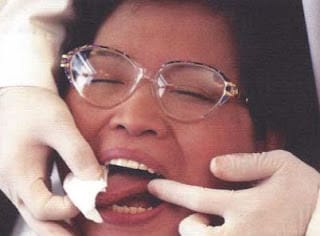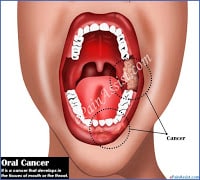Share this post
Research has identified a number of factors that may contribute to the development of oral cancer. The most common is the use of tobacco and alcohol. Others include poor oral hygiene, irritation caused by ill-fitting dentures and rough surfaces on teeth, poor nutrition, some chronic infections and combinations of these factors.
Studies have shown that the death rate from oral cancer is about four times higher for cigarette smokers than for nonsmokers. It is also widely believed in the medical field that the heat generated by smoking pipes and cigars irritates the mouth and can lead to lip cancer.
Are You At Risk of Oral Cancer?
Those at especially high risk of developing oral cancer are over 40 years of age, heavy drinkers and smokers, or users of smokeless tobacco, including snuff.
Detection - Self Exams of Oral Cancer
Because the mouth is a region where changes can be easily seen, oral cancer can be detected in its early stages. Performing a self-examination regularly will help in the early recognition and detection of oral cancer, and increase the chance for cure.
Oral and maxillofacial surgeons recommend that everyone perform an oral cancer self-exam each month. If you are at high risk - smoker, consumer of alcohol, a user of smokeless tobacco, or snuff - you should see your general dentist or oral and maxillofacial surgeon for an annual exam.
- RELATED READING: 8 HABITS TO QUIT THAT ARE RUINING YOUR HEALTH
An oral examination is performed using a bright light and a mirror:

- remove any dentures
- look and feel inside the lips and the front of gums
- tilt head back to inspect and feel the roof of your mouth
- pull the cheek out to see its inside surface as well as the back of the gums
- pull out your tongue and look at all of its surfaces
- feel for lumps or enlarged lymph nodes (glands) on both sides of the neck including under the lower jaw
When performing an oral cancer self-examination, look for the following:
- white patches of the oral tissues - leukoplakia
- red patches
- red and white patches - erythroleukoplakia
- a sore that fails to heal and bleeds easily
- an abnormal lump or thickening of the tissues of the mouth
- a chronic sore throat or hoarseness
- difficulty in chewing or swallowing
- a mass or lump in the neck
If You Detect an Abnormal Growth of Oral Cancer
If you have detected an abnormal growth, or if you are at higher than normal risk for oral cancer, make an appointment to see You will perform a thorough examination to determine if there is any reason to worry and can help you understand all of your options should you require additional care.
An amazing number of different kinds of growths or lesions (benign or malignant) can form in the mouth or around the head, scalp or neck.
Oral healthcare providers are among the most influential professional group in the fight against tobacco-related health problems including oral cancer. Your dentist will perform a screening during each exam.
Signs of oral cancer change in color or texture of soft tissue, persistent sore throat, slow healing cuts or sores and lumps in mouth, throat, and neck. A sample of the abnormal tissue is taken and sent to a laboratory for testing. Some lesions can be removed by an oral surgeon while others may be managed medically.
If you have any questions or concerns, please contact Dentist nearest to you or your dentist.
RELATED READING

Isreal olabanji a dental assistant and public health professionals and has years of experience in assisting the dentist with all sorts of dental issues.
We regularly post timely and trustworthy medical information and news on Fitness, Dental care, Recipes, Child health, obstetrics, and more.

